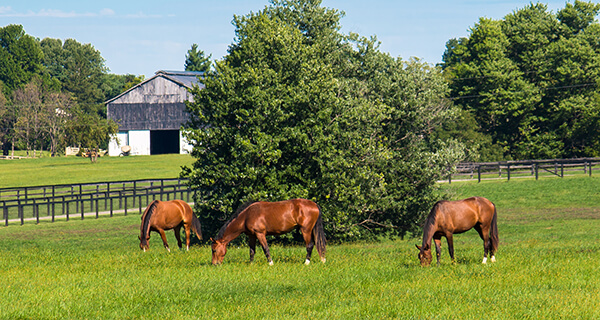General Guidelines
- In general, horses, cattle and other farm assets may be eligible to be depreciated once purchased and placed in service. Horse and farm owners may now use the 200% declining balance for qualifying assets. If the 150% declining balance is preferred, an irrevocable election may be made to utilize this.
- Some examples of depreciable lives for common equine assets:
- 3 years: Yearlings placed in service through 12/31/2021, racehorses over 2 years old, any horse other than a racehorse (i.e., breeding stock) which is more than 12 years old
- 5 years: NEW (but not used) farm equipment, cattle
- 7 years: Any horse other than a racehorse which is 12 years old or less, farm equipment not eligible for 5-year life, fencing, racing prospects 2 years old or less (yearlings) placed in service after 12/31/2021
- 15 years: land improvements such as road
- 20 years: barns
- It is important to note that the depreciable life for horses depends on the actual age of the horse (based on foaling date versus the January 1 industry standard) when placed in service. Inventory items, such as weanlings or weanling to yearling pinhooks, are not eligible to be depreciated.
- Assets used predominantly outside of the U.S. and electing farm businesses for purposes of the business interest limitation are required to use the alternative depreciation system (ADS) for certain assets which are also not eligible for the Federal bonus depreciation covered below.
Bonus Depreciation
- Federal bonus depreciation has been significantly expanded, increasing the deduction in the first year and the type of qualifying property which is eligible for this first-year deduction.
- Through 2023, 80% of the purchase price may be depreciated when the horse or other qualifying asset is placed in service.
- After 12/31/2023, the bonus depreciation percentage decreases by 20% each year (so 60% in 2024, 40% in 2025, 20% in 2026 and zero thereafter).
- In order to qualify, the property must not have been previously owned by the purchaser, must not have been acquired from a related party or via gift or inheritance, and must be predominately used in the United States.
- Examples of potentially qualifying property are yearlings, racehorses, breeding stock, equipment, fencing, land improvements, and barns.
- Bonus depreciation applies to large and small businesses – there are no sized-based limits and the deduction is allowed whether or not the business has taxable income. It is also not prorated based on the time of year that assets are placed in service.
- An annual election out of this bonus depreciation is available on an asset class-by-class basis.
Section 179 Depreciation
- The 2023 annual limit for Section 179 expense is $1,160,000 but this starts to phase-out dollar-for-dollar if qualifying property additions exceed $2,890,000 (adjusted annually for inflation). For 2024, the Section 179 limit is $1,220,000 on up to $3,050,000 of qualifying property.
- Like bonus depreciation above, the deductible amount is not impacted by when during the year the property is placed in service – late year qualifying additions receive full benefit.
- Property previously owned may also qualify for this deduction.
- However, this deduction is available only to the extent of the taxpayer’s net business income.
Limitations
- Excess Business Loss limitations (applicable through 2028) – may apply for individuals, trusts or estates. While not equine-specific, net business losses are subject to an annual limitation through 2028, adjusted annually for inflation, with the excess treated as a net operating loss carry-forward. In 2023, total net business losses – both equine and non-equine – are limited to $289,000 ($578,000 if filing a joint tax return). If net business losses exceed this limit, this results in a deferral of the excess loss subject to the net operating loss carry-forward rules (eligible to offset up to 80% of taxable income in subsequent years).
- Hobby loss rules and – separately – the passive activity rules may either limit the deductibility or defer depreciation expense into future years.
- Many states have decoupled from the accelerated depreciation provisions so the accelerated depreciation may be a Federal-only tax benefit (merely a timing difference).
Click here to download the summary.
The matters discussed above provide general information only. Industry participants should consult with their professional advisors about their specific situation before undertaking action based on such general information.







